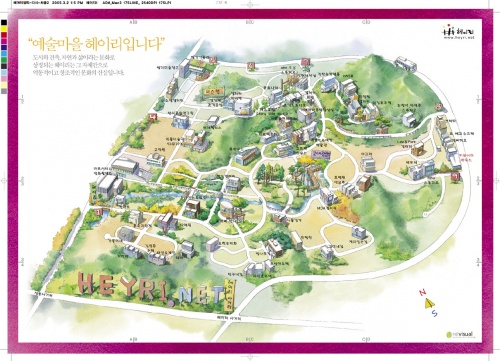-
Heyri Art Valley

Bauhaus on the Imjin”
Or so one could conceivably call Paju’s Heyri Art Valley, a collection of art galleries, workshops, film studios, book shops and cafés, hidden away in an idyllic valley just an hour’s drive north of Seoul. Along wi th nearby Paju Book Ci ty, Heyr i is a grand experiment in ecologically friendly architecture, design and urban planning, made all the more amazing—or surreal, depending on your current state of mind—by its location just a river’s width from North Korea. An outdoor museum (with plenty of indoor ones, too) that even philistines without the slightest interest in the arts can enjoy, it’s a place you could spend all day strolling about, dipping in and out of galleries and bookshops as the mood strikes.
Nature, Industry and Design
Heyri Art Valley was born in 1997 as part of a larger effort to cultivate the cultural industries in a frontier region long underdeveloped and overmilitarized due to the national division. The community is spread out in a quiet hillside valley beside the lower end of the Imjingang River, right where the waterway empties out into the larger Hangang River. Across the river is North Korea—on your way to the village, you’ll pass miles of barbed wire fence and watchtowers along the southern bank of the river, manned by South Korean troops. This makes the village a symbol of peace and sustainability in a land scarred by war and destruction. About 370 artists—including painters, sculptors, graphic artists, filmmakers and potters—live and/or work in Heyri. Korea’s top architects were let loose to design the studio and art spaces, and the result—an outdoor display of the very best of eco-friendly Korean design—is absolutely breathtaking. Each and every building is an expression of the individuality of both architect and owner, yet all strictly conform to the village’s overriding principle of harmony with nature. They are designed to harmonize with and complement the hills and streams. By regulation, none are more than three stories high. Tying the village together is a series of walking paths, winding roads and picturesque bridges.Have a Cup of Tea
It feels as if Heyri has more cafés and teahouses per square foot than anywhere outside Apgujeong-dong. Many of the bookshops and exhibit halls also have cafés, and any at tempt to l ist them would fal l dreadfully short.
One particularly popular café, however, is the one in Gallery TouchART. It’s got your usual assortment of coffees and teas (and waffles, to boot!), but its real charm is its location, looking out on Heyri’s centrally located pond and Reed Square.
Nearby Sites
Odusan Unification Observatory: On the road to Heyri is the Odusan Unification Observatory, which overlooks the confluence of the Imjingang and Hangang rivers. More to the point, however, it overlooks North Korea, which is just 460m away.
Paju Book City: Like Heyri, Paju Book City—a collection of Korean publishing houses—is an outdoor exhibit of cutting-edge architecture and design, designed to harmonize with its wetland environment. Bus 2200 passes through it on the way to Heyri. Tags : heyri art valley
Tags : heyri art valley
-
Commentaires
